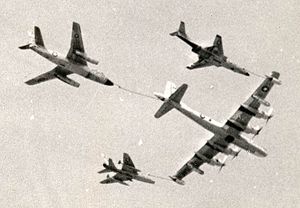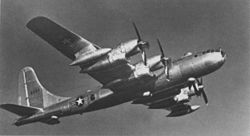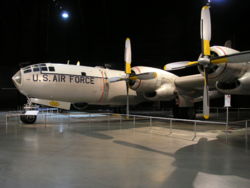PlaneSpottingWorld welcomes all new members! Please gives your ideas at the Terminal.
B-50 Superfortress
| B-50 Superfortress | |
|---|---|
| B-50 Lucky Lady II, the first-ever aircraft to fly around the world nonstop. | |
| Type | Strategic bomber |
| Manufacturer | Boeing |
| Retired | 1965 |
| Primary user | United States Air Force |
| Produced | 1947-1953 |
| Number built | 371 |
| Unit cost | US$1,144,296[1] |
| Developed from | B-29 Superfortress |
The Boeing B-50 Superfortress was a post-World War II revision of the wartime B-29 Superfortress with new, more powerful Pratt & Whitney R-4360 radial engines, a taller vertical stabilizer, and other improvements.
The USAF Strategic Air Command had B-50 Superfortresses (B-50s and RB-50s) in service from 1948 through 1954.
Boeing built 371 of these between 1947 and 1953, some serving until 1965. A reconnaissance variant, the RB-50B (a B-50B conversion) existed and played an important role in Cold War espionage. An aerial refueling tanker conversion designated KB-50 was used in the Vietnam War.
In 1949, the B-50 Lucky Lady II, commanded by Captain James Gallagher, became the first airplane to circle the world nonstop. This was achieved by refueling the plane in flight.
While not many were ordered, the B-50 was the ultimate expression of the B-29 family and one of the last piston-engined bombers built. The B-50 was retired from its main role as atomic bomber in 1955. A number were converted into KB-50 tankers and lasted long enough to be deployed to Southeast Asia in support of tactical operations. The type was grounded and removed completely from inventory when wreckage of a KB-50 that broke up in flight in 1965 revealed corrosion problems in the fleet. No flying examples exist today, although several can be found in various air museums.
It started as B-29D, but given a new B-50 designation- a common practice under this designation system and era. Unlike later designation system aircraft families were given many more later number combinations;the DC-2 family was given over 8 different letter number combinations for example.

Variants and Design Stages
- XB-44: One B-29A was handed over to Pratt & Whitney to be fitted with the new Wasp Major 28-cylinder engines. Initially designated B-29D, this was eventually changed to B-50A in December 1945. (x1, converted)
- B-50A--First production version of the B-50. It had new wings that were stronger and lighter than the units on the B-29. It also had taller vertical tail than the B-29. (x60)
- B-50B--Increase in gross weight over the A model, from 168,480 lb (76,420 kg) to 170,400 lb (77,290 kg). Also included a new type of lightweight fuel cell. (x45)
- B-50D--Definitive production version of the B-50. The 7-piece nose cone window was replaced by a single plastic cone and a flat bomb-aimer's window. Many included the new boom-type refueling system. (x222)
- DB-50D--Drone director conversion of a B-50D, to be used with the GAM-63 Rascal missile. (x1, converted)
- EB-50B--Single conversion of a B-50B to be fitted with a track-tread undercarriage. (x1, converted)
- KB-50--Air to air refueling tanker conversions of the bomber. (x134, converted)
- KB-50J--Tanker B-50s with improved performance, via two extra General Electric J47 turbojets under the outer wings. (x112, converted)
- KB-50K--Tanker conversions of the TB-50H trainer aircraft. (x24, converted)
- RB-50B--All but one of the B-50Bs were converted into the recon role. These were fitted with nine cameras in four stations, weather instruments, and a bomb bay capsule holding the extra crew members. (x44, converted)
- RB-50E--Special photographic conversions of the RB-50B, modified at Wichita. (x14, converted)
- RB-50F--Conversions of the RB-50B, fitted with SHORAN navigation radar for special missions. (x14, converted)
- RB-50G--Conversions of the RB-50B, fitted with electronics countermeasures statios along with the SHORAN radar. (x15, converted)
- TB-50A--Trainer conversion of the B-50A. (x11, converted)
- TB-50D--Trainer conversion of the B-50D. (x11, converted)
- TB-50H--Newly built trainer planes. (x24)
- WB-50 --Weather reconnaissance conversion of the B-50.
- WB-50D--Weather reconnaissance conversions of outdated B-50Ds, fitted with meteorological equipment. (x36, converted)
- YB-50C--Version to be fitted with the Variable Discharge Turbine version of the R-4360 engine. None were built.
- B-54A--Proposed version of the YB-50C.
- RB-54A--Proposed reconnaissance version of the YB-50C.
Specifications (B-50D)
General characteristics
- Crew: 8: Pilot, co-pilot, flight engineer, radio/electronic countermeasures operator, 2 side gunners, top gunner, and tail gunner
- Length: 99 ft 0 in (30.2 m)
- Wingspan: 141 ft 3 in (43.1 m)
- Height: 32 ft 8 in (10.0 m)
- Wing area: 1736 ft² (161.3 m²)
- Empty weight: 80,610 lb (36,560 kg)
- Loaded weight: 121,850 lb (55,270 kg)
- Max takeoff weight: 173,000 lb (78,470 kg)
- Powerplant: 4× Pratt & Whitney R-4360 radial engines, 3,500 hp (2,600 kW) each
Performance
- Maximum speed: 395 mph (343 knots, 636 km/h)
- Cruise speed: 244 mph (212 knots, 393 km/h)
- Combat radius: 2,100 nm (2,400 mi, 3,860 km)
- Ferry range: 5,000 nm (5,760 mi, 9,270 km)
- Service ceiling: 36,650 ft (11,170 m)
- Rate of climb: 2,225 ft/min (11.3 m/s)
- Wing loading: 70.19 lb/ft² (343 kg/m²)
- Power/mass: 0.115 hp/lb (193 W/kg)
Armament
- Guns:
- 12× .50 in (12.7 mm) M2 Browning machine guns in remote controlled turrets
- 1× 20 mm (0.787 in) cannon in tail
- Bombs:
- 20,000 lb (9,100 kg) internally
- 8,000 lb (3,600 kg) on external hardpoints
References
- ↑ Knaack, Marcelle Size (1988). Post-World War II bombers, 1945-1973. Office of Air Force History. ISBN 0-16-002260-6.
- Baugher, Joe (2000-06-17). Boeing B-50 Superfortress. Encyclopedia of American Aircraft. Retrieved on 2005-12-06.
Related content
Related development
Comparable aircraft
Designation sequence
| 345 (B-29) | - 367 - 377 - 400 | |
| 345 (B-39) | ||
| 345 (B-44) | ||
| 345 (B-50) |
Related lists
See also
Lists relating to aviation | |
|---|---|
| General | Timeline of aviation · Aircraft · Aircraft manufacturers · Aircraft engines · Aircraft engine manufacturers · Airports · Airlines |
| Military | Air forces · Aircraft weapons · Missiles · Unmanned aerial vehicles (UAVs) · Experimental aircraft |
| Notable incidents and accidents | Military aviation · Airliners · General aviation · Famous aviation-related deaths |
| Records | Flight airspeed record · Flight distance record · Flight altitude record · Flight endurance record · Most produced aircraft |
cs:B-50 Superfortress de:Boeing B-50 fr:Boeing B-50 Superfortress it:Boeing B-50 ja:B-50 (爆撃機) pl:Boeing B-50 Superfortress



